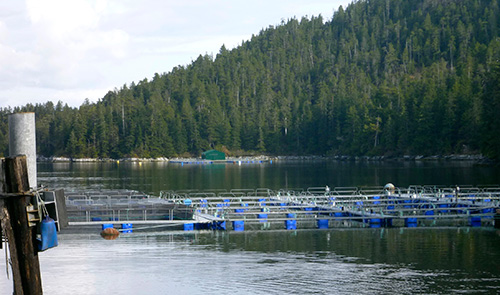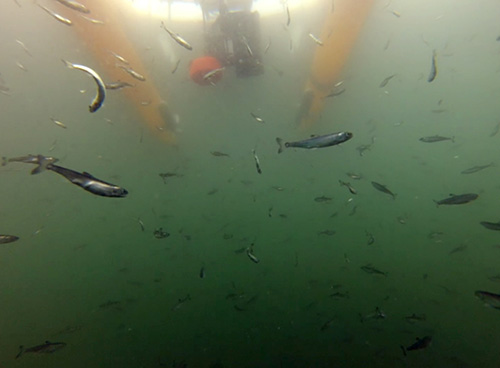
Fast food appeals to humpback whalesBy LAUREN FRISCH
October 20, 2015
Ellen Chenoweth, a Ph.D. student at the University of Alaska Fairbanks School of Fisheries and Ocean Sciences, is studying which whales are feeding on the juvenile salmon and why they are choosing to feed there. Wild juvenile salmon are likely a normal part of a humpback whale’s diet. In addition, there are plenty of humpback whales that swim by the hatcheries without interest. If Chenoweth can pinpoint why certain whales are choosing the hatchery fish when it’s time for a meal, she can work with hatchery managers to suggest release strategies so hatcheries aren’t creating all-you-can-eat buffets for hungry whales.
Hidden Falls hatchery release site in Kasnyku Bay.
Juvenile salmon are released into the ocean in large, dense schools. These schools can be an efficient source of food for predators because they maximize the number of calories predators take in per bite. Eating is hard work for a humpback whale. Humpbacks are bulk filter feeders, meaning they eat a lot of small fish per bite. The whales feed by diving from the surface to the depth of their prey, lunging quickly at the prey, taking a mouthful, and then resurfacing for air. By expanding their throats, whales can suck in a volume of water equal to their body weight with a single mouthful. Then they filter out food with their baleen and spit out the remaining water. The lunging process is energy intensive, and humpback whales need to eat a lot of tiny juvenile salmon to get a sufficient number of calories. So it is most efficient for whales to feed on large, dense prey patches with a high concentration of calories per bite. “Where the fish are packed together tightly, that’s where the whale wants to feed,” Chenoweth said. Chenoweth is part of the Marine Ecosystem Sustainability in the Arctic and Subarctic program at UAF. Funded by Alaska Sea Grant and the National Science Foundation, Chenoweth works closely with four state-supported Baranof Island hatcheries — Hidden Falls, Mist Cove, Little Port Walter and Port Armstrong. With the exception of Little Port Walter, which is focused on fishery research, the hatcheries enhance stocks available to commercial fishermen in Chatham Strait. The hatcheries have been involved in this research since it started in 2010. In fact, hatchery managers initiated the effort by seeking help to find a way to minimize humpback feeding. They approached Jan Straley, an associate professor at the University of Alaska Southeast and the project’s principal investigator. The program began with a volunteer monitoring effort — hatchery workers recorded their observations on predators every morning and afternoon. Straley and Chenoweth are tagging whales and tracking where they feed. They also use echosounders, which generate sound waves to measure underwater distances, illustrating the characteristics of prey patches hungry humpbacks feed on first. The echosounders collect information on where the fish are bunching up, how dense the prey patches are, how deep the patches are, and how the hatchery patches compare to prey patches made up of wild fish. The hatcheries have also been sharing release and return data since 2010, including location, time of day, length of release and number of returns.
Four gram juvenile chum salmon on their first day of freedom. An echosounder visible on the surface is measuring their density.
Some hatcheries are already implementing alternate release strategies. Using a trickle release — releasing hatchery fish over a period of time rather than all at once — can make prey patches smaller. In addition, if a whale approaches the release site in the middle of a trickle release, the hatchery can temporarily hold off on the release until the whale leaves. Another option is to release fish once they have grown to be a bit larger and tougher. For example, the 4.0 program developed by Hidden Falls is an effort to study how return rates are affected if the hatchery waits to release fish until they have grown to 4 grams, or the mass of about 4 skittles. Usually, chum salmon are released when they are 2 grams, so the 4-gram program doubles the mass of these juveniles. The first 4-gram fish were released in 2012, and researchers began measuring the fish that returned from this stock in 2015. Rearing fish in the hatchery for a longer period of time comes with additional costs, such as increases in fish food and labor. However, Chenoweth believes that if the change causes even a slight increase in return rates for the hatcheries, the program will be worthwhile. Humpback whales are not the only predators that feed on these salmon, so there’s always the risk that changing prey patch characteristics may deter humpbacks but make feeding more convenient for other predators such as pollock, Dolly Varden, seals, river otters or birds. Given the number of variables to consider, it’s a tough call for the hatcheries to figure out the best way to release their fish. Hatchery release sites are usually risky locations for whales to be feeding in the first place. The release sites tend to be close to shore, with more boat activity, mooring lines and nets. This means there is a higher risk of entanglement for the whales. Implementing strategies that deter whales from feeding at hatchery release sites protects the whales as well as the salmon.
On the Web:
Editor's Note: Hidden Falls Hatchery is located in Kasnyku Bay on Baranof Island on Chatham Strait. This hatchery was built by the State of Alaska in 1978-79 and operated by the State until 1988 when operational responsibility was transferred to NSRAA. http://www.nsraa.org
This article is provided as a public service by the University of Alaska Fairbanks School of Fisheries and Ocean Sciences. Lauren Frisch [lcfrisch@alaska.edu] is a writer with the School of Fisheries and Ocean Sciences.
|
||

